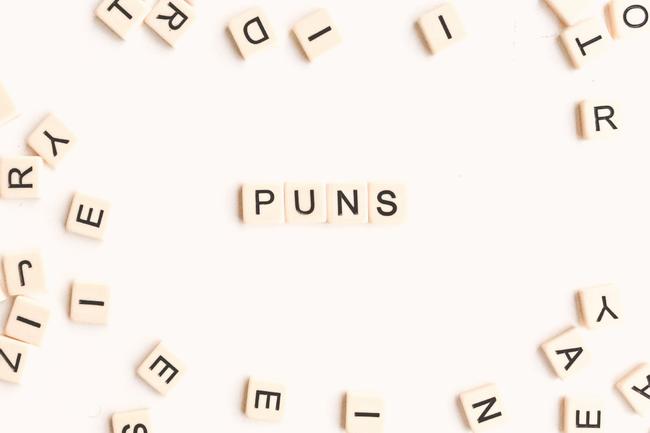 by Ingrid Stobbe
by Ingrid Stobbe
Throughout my time teaching I’ve developed the practice of opening classes when possible with a new joke – usually featuring a pun, for reasons we will visit shortly. While for some time an opening joke has served the purpose of democratizing the space and allowing for play, what has become apparent in the primarily online learning spaces of our current pandemic is that that opportunity for play has never been so important. And an understanding of what play looks like in times of great stress can lead to greater understanding and empathy between students and professors.
But, first, why is the pun, in particular, a successful communicative bridge?
More often colloquially referred to as a “dad joke,” the pun is, quite simply, a spectacular warmup to more difficult educational concepts. In several important ways, it lights up key thought processes and promotes classroom inclusivity simultaneously. Let’s elaborate with a fitness metaphor: No one is timing you on an opening stretch- there’s no pressure there. And no one starts their yoga practice with a Bird of Paradise pose – that’s just wild. So, if we pause for a moment, why would we ever jump into a challenging or difficult concept without creating an environment where the brain knows it has an opportunity to warm up its muscles, so to speak? And most importantly, to fail in a safe space. A well-delivered pun is both engaging, and playful. The neurons are warming up and we’ve learned from childhood that in this case, it’s ok to be wrong. It’s fun, in fact. And right now, that allowance of fun – of a safe space – is so incredibly important.
So what exactly is so safe about these jokes? This specific brand of humor works well because it intrinsically ties together a collective eye roll towards linguistic silliness and an affection for the playful environment that silliness creates. I’ve discovered there’s actually a method to this madness, as humor has been widely documented as an aid to social interactions from a scientific perspective. The deceptively complex pun aids in communication between the left and right brain. In the Wall Street Journal’s “What Can Science Tell Us about Dad Jokes,” Heidi Mitchel cites work in “a 2016 study published in the journal Laterality [that] showed that the brain’s left hemisphere processes the language of the pun first, while the right side takes a few beats to catch the ambiguous dual meaning.” Further work, such as “Laughing and liking: Exploring the interpersonal effects of humor use in initial social interactions” by Stanislav Treger, delves into the notion that “Humor is a common interpersonal phenomenon that may positively influence the trajectories of social interactions.” The inclusive effect of humor combined with the intellectual potential of a great pun, is a perfect mental warm up for the educational environment.
It’s important to note that while perhaps unfairly assigned to “dads,” the successful pun in and of itself doesn’t have a gender. In the name of forging the right path here, it should be acknowledged that not everyone has a dad in their family, and obviously that’s ok. Anyone, however, can deliver a solid pun; they are universal! I’ve removed the “dad” from my descriptions in class and just call them “jokes”- not because my own dad didn’t hold it down as the primary source of pun fun in our family, but because as Neil Levy articulated in “Is ‘Dad Joke’ Sexist,” “[While] calling this genre of jokes ‘dad jokes’ doesn’t strike me as directly wrong, it may nevertheless be indirectly wrong. I think it expresses – and perhaps plays a small role in reinforcing – attitudes that are bad for men and for women.” While some may feel the term has transcended the gender-specific identifier, it’s not a safe assumption to assume that everyone shares that mentality.
But how are these jokes utilized? Well that depends on the delivery. Puns fall primarily into 4 categories, with some working well for audible jokes, others for visual. Those that give you the option of providing interactivity verbally are good for initial conversation and warming up the neurons at the beginning of the day. Those that can provide the option for visuals (I’ve received some very intriguing sketches) are a way to lighten up an exam with a bonus point or two.
Four key pun categories and examples are:
Homophonic: Word pairings that sound alike but are not synonymous.
Why did the scarecrow win an award? He was outstanding in his field.
Homographic: Words that are spelled similarly but possess different meanings and sounds.
You can tune a guitar, but you can’t tuna fish.
Compounded: A statement that contains two or more puns.
Piano is not my forte.
Recursive: When the second element of a phrase relies on an understanding of the first for its meaning.
A Freudian slip is when you say one thing but mean your mother.
Play has existed in evolution to develop skills for adaptation and learning – whether you’re a human, a primate, or a cheetah. And groan-inducing as these puns may be, they harken back to play as an inclusive device. If everyone is groaning at me, they are not groaning at one another. And you make of yourself, as the head of the classroom, the pinpoint for a playfully tolerated vexation. But notably, you also divert attention away from potential othering, as students often work in tandem to find answers – or in some cases, draw a picture to better express themselves. Essentially, you’ve created a team, and a space where lots of different answers are acceptable in the name of a great pun. No small feat in the online classroom, in which concerns of technological equity, student focus, and overall inclusion surface in myriad ways. In other words, in addition to simply getting ready to learn, during their time with you students have the opportunity to find some degree of comfort in a world that has caused at times incredible stress this year.
Works Cited
Levy, Neil, “Is ‘Dad Joke’ Sexist,” The American Journal of Bioethics (www.Bioethics.net)
Mitchel, Heidi, “What Can Science Tell Us about Dad Jokes,” The Wall Street Journal
Treger Stanislav, “Laughing and liking: Exploring the interpersonal effects of humor use in initial social interactions,” The European Journal of Social Psychology.
“What is a Pun?” www.Masterclass.com
Ingrid Stobbe is an award-winning Visual Media Artist and Educator. Her films have screened and exhibited nationally and internationally, and recently featured in Boston Voyager Magazine, and Palaver Journal. Her writing can be found in a variety of publications, including Mantra Wellness Magazine, Psychology Tomorrow and The Glossary. Her film Orange can be seen in SoAnyway Magazine’s 2nd Volume and on exhibit at the Royal Scottish Academy of Art & Architecture, while select paintings were recently chosen for “The Art Edit,” Condé Nast’s curated fall advertorial campaign showcasing independent two-dimensional artists in House & Garden, UK. She is an Assistant Professor of Digital Filmmaking at Lesley University’s College of Art & Design in Cambridge, and serves on the board of Women in Film & Video New England. In 2020 her pedagogy was internationally recognized with the University Film and Video Association’s Award of Teaching Excellence.


